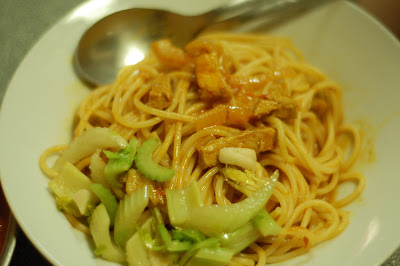Though the name sounds foreign, it is actually somewhat like a Bolognese, with a twist : )
So here goes...
First, prepare your ingredients. For your information, this dish is from Jamie Oliver and it was featured in his 'Jamie's 30-minute meals' TV show. He used a food processor to whaz up almost all the ingredients. I do not have a food processor, hence, I used the old school method - manual chopping. You can find out the exact recipe via the Internet as mine had some modifications due to insufficient ingredients : P
Chop up spring onions, carrots and chillis into smaller bits. Then fry them in a pan with some heated oil. Remove the linings of 4 sausages and put the meat into the pan as well. As you fry, try to 'mince' the meat up into smaller pieces and pour some oregano/mixed herbs.
 |
| Fry fry fry and mince mince mince! |
Since the ingredients are not whazzed into fine bits, continue to fry the mixture a little while more to ensure everything's cooked and softened. While leaving the mixture to simmer away, pour in some balsamic vinegar onto the meat and let the liquid reduce. Slice up some garlic and put it in too! Finally, pour in a tin of plum tomatoes and season the sauce. The Ragù is done!
As for the pasta, boil the penne pasta until it is softened. You can boil this while preparing the sauce. Once the pasta is ready to be drained, scoop up some of the pasta water out and put it aside. Remove the sauce from heat and mix the pasta into the sauce. Add in some of the pasta water to make a more sticky texture.
Although the ingredients are kinda chunky, the taste was refreshing. It has the usual bolognese taste but with a hint of spicyness. It's like an adult version of bolognese. As for the meat, I would prefer mince meat instead of the sausage fillings. This is because I like the meaty texture than the 'processed' meat texture. Also, using spring onion gives a milder onion sweetness - great for people who prefer a milder onion taste in their pasta.
Yum yum! We made such a big pot that we have leftover for our next day's lunch. Mmm!
Next up - Chinese Steamed Chicken! Yum yum yum for me!












